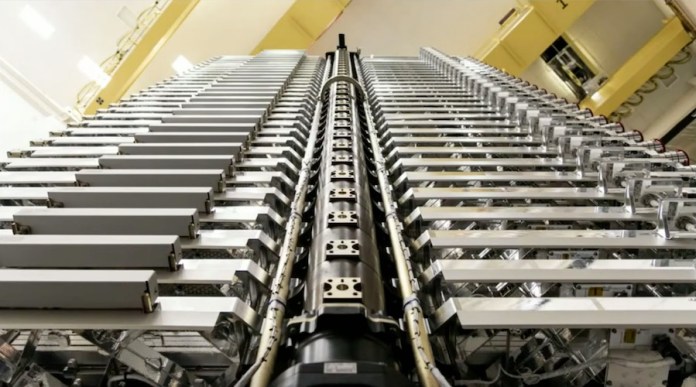A SpaceX Falcon 9 rocket stands to the next Starlink launch of the company month on pad 40. Credit: Stephen Clark/Spaceflight NowDays SpaceX is set to restart a speedy cadence of satellite launches Wednesday night using liftoff of a Falcon 9 cop after launching astronauts for the first time.
A Falcon 9 rocket is scheduled for takeoff Wednesday, likely around 9:25 p.m. EDT (0125 GMT Thursday), from Cape Canaveral’s Complex 40 launch pad. A weather forecast issued by the U.S. Space Force’s 45th Weather Squadron on Monday suggests there’s a 70 percent probability of favorable conditions for launch Wednesday night.
SpaceX has launched 420 Starlink satellites with every rocket carrying 60 Starlink spacecraft, on seven May 2019 committed Falcon. This week’s launch is expected to loft around 60 Starlink satellites, which each weigh about a quarter-ton.
This launch was scheduled for mid-May. SpaceX delayed the launch after Tropical Storm Arthur brought high winds and rough seas where SpaceX ship has to be positioned for landing of the 9 rocket’s first stage booster.
Once the launch delay was compelled by Tropical Storm Arthur, SpaceX decided to maintain the Starlink mission until after the company launched the Crew Dragon spacecraft from pad 39A at the Kennedy Space Center. The Crew Dragon launched Saturday using NASA astronauts Doug Hurley and Bob Behnken, the first crewed mission to launch into orbit from U.S. soil since the retirement of the space shuttle in 2011.
The ship was used for the landing of the Falcon 9 phase after the Crew Dragon launch.
Another drone ship in SpaceX’s fleet — named”Just the Read Instructions” — has completed updates and departed Port Canaveral, Florida, to support the booster landing to get the next Starlink launch.
An opinion of the 60 Starlink satellites stacked before a launch. Credit: SpaceXThe weather issues for Wednesday night’s launch attempt are with violations of the cloud and rules.
“Models have trended slightly faster using the returning moisture throughout the last several days, but a few dry air is still expected to linger at the mid-levels.
“The main concerns is going to be the cloud layer rule due to upper level clouds flowing in from the west, and the cumulus cloud rule due to the possibility of isolated showers.”
The Falcon 9 rocket for another Starlink mission completed a hold-down test-firing of its Merlin engines May 13 on pad 40.
The phase assigned to the week’s launch is a veteran of four previous flights, landing on a SpaceX drone ship after every mission. The booster first flew from Cape Canaveral at September 2018 using a Telesat communications satellite, then launched again from Vandenberg Air Force Base in California at January 2019 using 10 voice and data relay payloads.
Its flight occurred last May on the dedicated Falcon 9 launch for its Starlink program. Most recently, the booster launched Jan. 6 in Cape Canaveral and landed on a SpaceX drone ship abroad.
It is going to mark the first time SpaceX has regained a Falcon 9 period for a fifth time if the booster lands after Wednesday night’s launch.
SpaceX aims to launch around 1,000 more Starlink satellites and next year to start offering online services that is global. Initial testing of the Starlink network could start later this year, beginning in higher latitude regions like Canada and the United States, the organization says.
Thousands more Starlink spacecraft could launch in the coming years to meet global demand, according to SpaceX.
A new sunshade to reduce the brightness of the Starlink satellites will debut with this week’s launch. The visor will block sunlight from reaching the shiniest parts of the flat-panel spacecraft, which makes them less visible from the ground.
Scientists have raised concerns that tens of thousands of Starlink satellites — as envisioned by SpaceX — might influence observations through telescopes. SpaceX has answered with an darkening therapy that offered some decrease and the company says it’s changing the orientation of the Starlink satellites throughout the period after launch to turn their solar panels away from the sun.
The sunshade should offer a dimming effect that is significant, SpaceX states.
SpaceX plans Falcon 9 launches this month after the flight to deliver Starlink satellites into orbit from Cape Canaveral of this week.
Email the writer.
– Advertisement –
